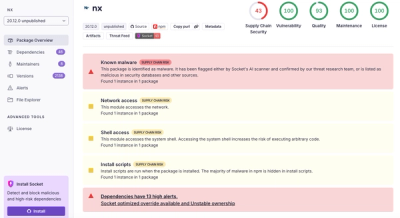
Security News
/Research
Wallet-Draining npm Package Impersonates Nodemailer to Hijack Crypto Transactions
Malicious npm package impersonates Nodemailer and drains wallets by hijacking crypto transactions across multiple blockchains.
@datasupply/datasupply
Advanced tools
Data Supply is an opinionated data processing, provision and presentation library of components for Javascript
Data Supply is an opinionated data processing, provision and presentation library of components for Javascript
❗ Please note this project is under early active development and probably not suitable for use yet.
Data supply supports NodeJS v12 and above.
The data supply toolset helps you to create a front end Javascript application for data visualisation and manipulation quickly and easily. Using data supply will make it easier to spend time on the presentation of your data, by making predictable decisions in order to get your data from files to components.
If you use data supply on many projects your display components will have more predictable, consistent interfaces, and will therefore be more reusable.
Data Supply is a set of opinionated libraries and configurations that save time for front end Javascript applications that deal with presenting data sets.
It is extensible and flexible, and should be usable with any modern browser-based Javascript project regardless of framework, with any file format and with any display component or library.
Data Supply is usable with no knowledge of how it works, but it's also easy to reason about, investigate and extend should you need to.
Data Supply is not an ORM or a database. It's not magic, and it's not a great leap forward. It does not do anything you can't do yourself using popular libraries. It just handles the boring stuff predictably so you don't have to.
Data Supply is not closed or restrictively licensed. Use it as much as you like on anything you like. If you do something useful with it, please consider opening a PR back into the librbary so others can benefit.
Data Supply consumes data from static file sources such as JSON and CSV files and allows you to predictably use that data in display components with a minimum of boilerplate. By using clear conventions and pragmatic defaults, Data Supply cuts out a lot of the boiletplate connecting data sources to stores and then via filtering and related functionality to display components.
Data Supply looks for a configuration file, and falls back to pragmatic defaults for any options that aren't configured. All the important decisions it takes can be overridden with configuration. All the important format- or framework-specific code it uses is pluggable and can be swapped out.
When Data Supply runs, it:
Data Supply does not make data relational, or know about relational data. It doesn't store data persistently. It doesn't make or receive network requests. It doesn't do any "magical" things that are hard to understand.
Please see the roadmap.
Read more documentation
Install the package (or if you're developing locally npm link it)
data supply provides a CLI.
Type supply.
Starting at the place where you typed supply data supply will visit all subdirectories find all CSV and TSV data files (and possibly JSON metadata files named THE_SAME_AS_THE_DATA_FILE.meta.json c.f. conventions) and convert them to a single JSON file in the standard array-of-objects format:
{
"data":[
{
"spreadsheet column 1":"value one",
"spreadsheet column 2":"value two",
"spreadsheet column 3":"value three"
},
...
],
"metadata":{
...
}
}
supply will look for a .datasupplyrc file in the location from which it was invoked.
If it doesn't find one it runs with default options...
{
"excludeDirectories": [".next", "node_modules"],
"fileTypes":[
{"extension": "csv", "delimiter": ","},
{"extension": "tsv", "delimiter": "\t"}
],
"dataSourceDirectories": ["."]
}
To specify your own config file you can type supply --config ./path/to/my/supply-config.json
Paths specified in supply-config files are relative to the location of that file so for example if in the config you set
{
"dataSourceDirectories":["spreadsheet-stash", "/global-data"]
}
then the script will look to source data from /path/to/the/config-file-directory/spreadsheet-stash, /global-data and all their subdirectories.
Thanks goes to these wonderful people (emoji key):
Marcel Kornblum 📖 🤔 | Tom Pearson 📖 | Chris Camplin 💻 |
This project follows the all-contributors specification. Contributions of any kind welcome!
FAQs
Data Supply is an opinionated data processing, provision and presentation library of components for Javascript
The npm package @datasupply/datasupply receives a total of 9 weekly downloads. As such, @datasupply/datasupply popularity was classified as not popular.
We found that @datasupply/datasupply demonstrated a not healthy version release cadence and project activity because the last version was released a year ago. It has 2 open source maintainers collaborating on the project.
Did you know?

Socket for GitHub automatically highlights issues in each pull request and monitors the health of all your open source dependencies. Discover the contents of your packages and block harmful activity before you install or update your dependencies.

Security News
/Research
Malicious npm package impersonates Nodemailer and drains wallets by hijacking crypto transactions across multiple blockchains.

Security News
This episode explores the hard problem of reachability analysis, from static analysis limits to handling dynamic languages and massive dependency trees.

Security News
/Research
Malicious Nx npm versions stole secrets and wallet info using AI CLI tools; Socket’s AI scanner detected the supply chain attack and flagged the malware.